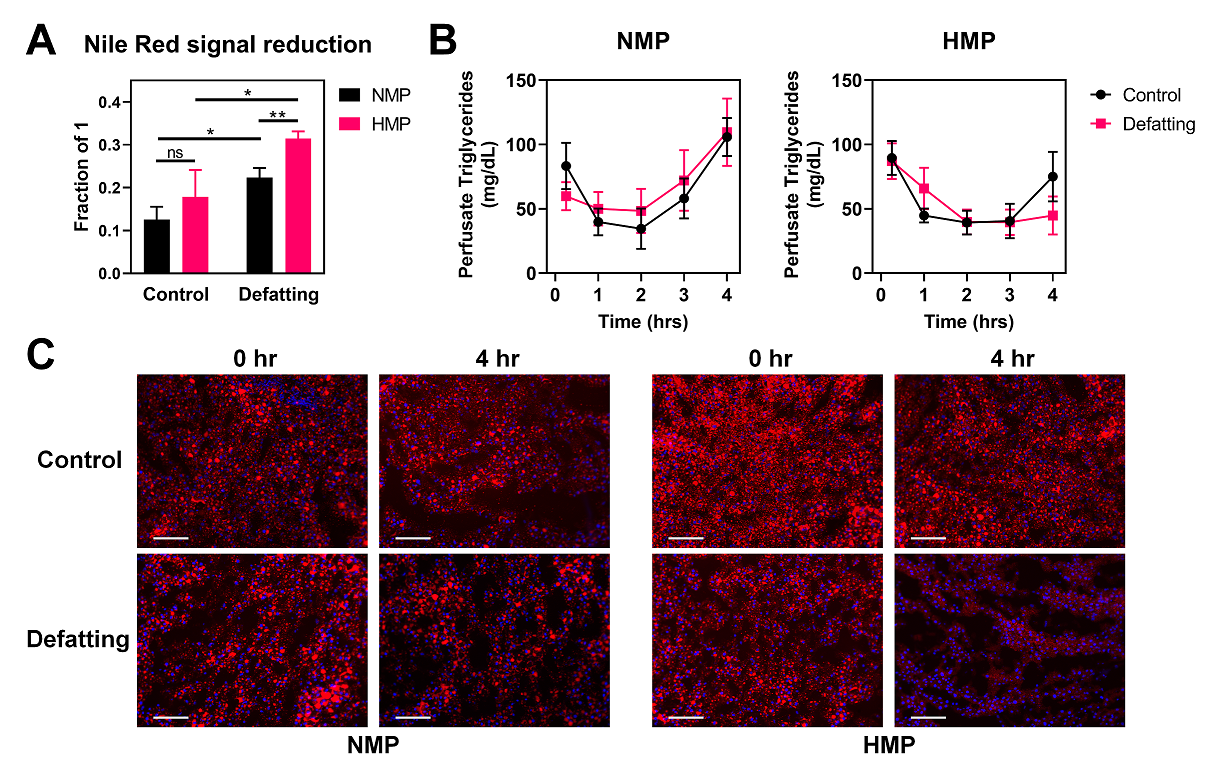Normothermic-Hyperthermic Machine Perfusion Could Increase Response to Pharmacological Intervention in Mitigation of Liver Steatosis
Surgery, Washington University in St. Louis, St. Louis, MO
Meeting: 2021 American Transplant Congress
Abstract number: 621
Keywords: Donors, marginal, Liver preservation, Machine preservation, N/A
Topic: Basic Science » Ischemia Reperfusion & Organ Rehabilitation
Session Information
Session Name: Ischemia Reperfusion & Organ Rehabilitation
Session Type: Poster Abstract
Session Date & Time: None. Available on demand.
Location: Virtual
*Purpose: To study the feasibility of mitigating rat liver steatosis with ex-situ normothermic-hyperthermic machine perfusion using a multi-drug ‘defatting’ combination.
*Methods: 16 male Zucker obese rats were randomized into 4 groups: Normothermic (NMP) control, NMP defatting, normothermic-hyperthermic (HMP) control and HMP defatting. Livers were procured and flushed with ice-cold HTK solution, placed in cold storage for less than 2 hours. Perfusate was prepared from rat full blood and buffered with bicarbonate solution under 95% O2 and 5% CO2 ventilation, additives include heparin, insulin, cefazolin, bile salt and epoprostenol. Machine perfusion was initiated and maintained at 37°C for 1 hour, after which defatting drugs (GW501516, GW7467, forskolin, hypericin, scoparone, and L-carnitine) were injected and temperature was increased to 40°C until a total course of 4 hours was reached. Perfusate samples were taken at 15min and hourly marks. Liver biopsies were taken before and after machine perfusion. Quantification of steatosis was done by calculating Nile Red relative fluorescence intensity from stained frozen section slides in ImageJ. Statistical analysis was done in GraphPad Prism.
*Results: In either NMP or HMP, defatting resulted in significant reduction of Nile Red fluorescence signal (NMP: *p=0.027, HMP: *p=0.046). While HMP alone did not show improvement in reducing steatosis (control, HMP vs. NMP: p=0.46), defatting drugs yielded increased efficacy under higher perfusion temperature (**p=0.007, Fig.1A). Nile Red staining images showed similar results (red: Nile Red, blue: DAPI, Fig.1C, scale bar 200μm): Red fluorescence decreased in defatting groups, with HMP being more pronounced, while control groups displayed no noticeable decrease. Additionally, perfusate triglycerides in NMP started increasing after 2 hours, while in HMP such trend was absent (Fig.1B).
*Conclusions: This study showed increased efficacy of defatting drugs using normothermic-hyperthermic machine perfusion. While HMP alone increases lipid metabolism, defatting drugs are key to reducing steatosis. This technique might be further improved to optimize for the benefit of accelerated metabolism and lowering the amount of injury and potential drug toxicity under prolonged exposure to hyperthermia.
To cite this abstract in AMA style:
Zhou F, Xu M, Upadhya GA, Lin Y, Chapman WC. Normothermic-Hyperthermic Machine Perfusion Could Increase Response to Pharmacological Intervention in Mitigation of Liver Steatosis [abstract]. Am J Transplant. 2021; 21 (suppl 3). https://atcmeetingabstracts.com/abstract/normothermic-hyperthermic-machine-perfusion-could-increase-response-to-pharmacological-intervention-in-mitigation-of-liver-steatosis/. Accessed December 24, 2025.« Back to 2021 American Transplant Congress

